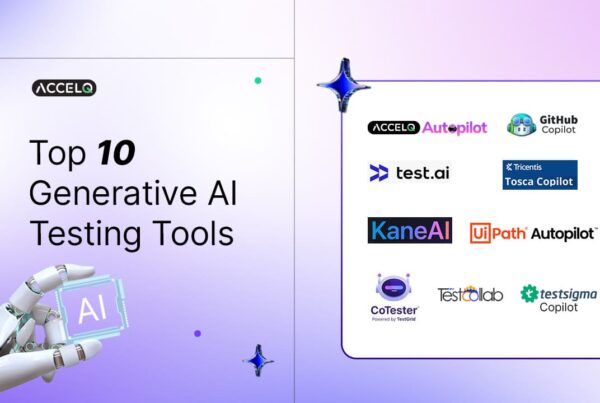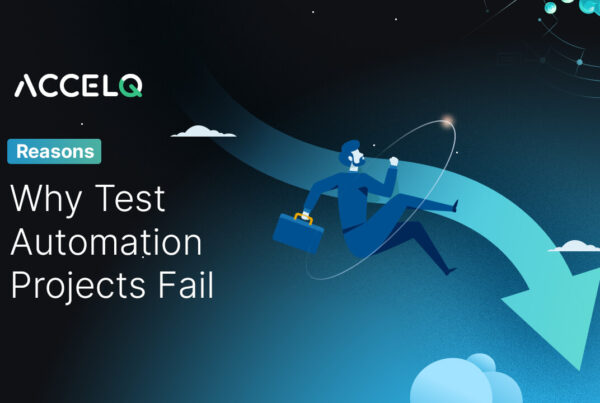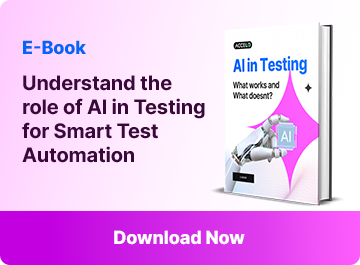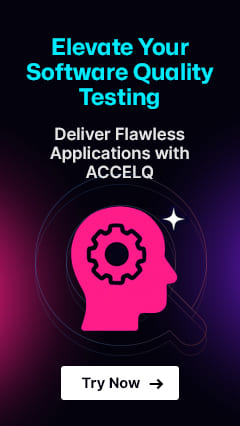AI Automation in Testing: The Future of Smarter, Scalable QA

Artificial Intelligence (AI) has revolutionized many industries, and test automation is not far behind. AI isn’t just beneficial for software testing, but it also positively redefines the testing process. When trained algorithms can analyse data, adjust to new issues, and forecast results, this is how AI test automation brings the need for accuracy, efficiency, and scalability in QA to the forefront.
Whether it’s automating tasks or finding hidden issues before they cause disaster in production, AI automation is transforming software quality in every facet. This blog explores the emergence of intelligent automation in testing, showcases real-world use cases throughout the software development lifecycle, and, most importantly, explains why forward-thinking enterprises are turning to platforms like ACCELQ to stay competitive in the era of continuous delivery.
Why Modern Testing Needs AI Automation?
Speed, quality, and agility are much needed in today’s software development. Manual testing lags too far behind the needs of continuous integration and deployment. This problem can be fixed (very computationally) by automating such repetitive work with the automated testing we recommend in this post. However, traditional automation encounters problems such as maintenance overhead, limited adaptability, and a lack of contextual awareness. This is where AI steps in to bridge the gap.
What is AI Test Automation?
It utilizes machine learning algorithms, natural language processing, and advanced data analysis in order to work for automated testing, not against it. Rather than constraining AI to predefined scripts, it allows the application of AI to monitor changes to the application, create or update test cases, and, in some cases, identify areas where it thinks it may be failing.
Key Characteristics:
- Self-healing scripts
- Predictive defect analysis
- Intelligent test case generation
- Visual and UI-based recognition
| Feature | Traditional Automation | AI-Powered Automation |
|---|---|---|
| Script Maintenance | High | Low (Self-healing) |
| Test Coverage Optimization | Manual | AI-Driven Insights |
| Test Data Generation | Static | Contextual & Dynamic |
| Test Case Authoring | Manual Scripting | No-code/Auto-generated |
How can AI help in automation testing?
1. Autonomous Test Case Generation
AI automation speeds up the authoring of test cases by utilizing the user behavior, requirements, and code changes. This enables testers to transition from manual scripting to smart, auto-generated tests.
Example: A financial services team creates test scenarios for the loan application workflow via AI-driven ACCELQ Autopilot. The system performs analysis on user journeys and data models to generate complete tests without any human input.
2. Intelligent Test Data Creation
Automation and AI-based tools can simulate real-world usage by generating diverse datasets for edge cases and high-volume scenarios. This is critical in domains like e-commerce, banking, and healthcare.
Example: For an e-commerce app, AI generates buyer personas and simulates varied cart behaviors, return patterns, and coupon redemptions.
3. Enhanced Visual Testing
AI can understand layout shifts, visual regressions, and user experience issues by comparing baselines and learning from past changes.
Example: A travel portal uses AI to detect UI inconsistencies across devices. Unlike pixel-based matching, the AI model learns what constitutes an acceptable design deviation.
4. Predictive Failure Analysis
Artificial Intelligence automation continuously learns from historical test data and environmental behavior to highlight probable failure points.
Example: A SaaS platform detects performance degradation in specific browser versions by identifying trends across past test failures.
Comparing AI, ML, and DL in Testing
| Aspect | Artificial Intelligence (AI) | Machine Learning (ML) | Deep Learning (DL) |
|---|---|---|---|
| Definition | Simulates human intelligence in software | Algorithms learn from data to improve tasks | Neural networks simulate the human brain for complex tasks |
| Scope | Broad – includes ML and DL | Narrower – focused on learning from data | Specialized – image, speech, or complex pattern recognition |
| Use in QA | Decision-making, smart test flows | Defect prediction, test optimization | Visual UI validation, voice command testing |
Real-World Benefits of AI Automation
Faster Release Cycles
With automation and AI-assisted testing, teams can keep up with continuous delivery timelines by identifying regression risks faster.
Higher Test Coverage
AI recommends untested paths and scenarios based on system behavior, improving depth of testing.
Cost Efficiency
Reduced rework, fewer false positives, and autonomous updates make AI testing more cost-effective.
Cross-Platform and Integration Testing
AI can manage dependencies and validate integrations across complex application ecosystems.
Why Enterprises Choose ACCELQ for AI Automation?
ACCELQ uses AI to automate web, API, mobile, and packaged apps in a single, consolidated platform. No-code logic building, auto-discovery of test flows, and tight CI/CD integration enable QA teams to increase speed and decrease maintenance.
Highlights:
- No-code test authoring with GenAI-powered logic builder
- Smart scenario discovery with Autopilot
- Native integration with enterprise apps like Salesforce, Oracle, and SAP
Challenges AI Solves in Test Automation
| Category | Key Challenge | AI Solution |
|---|---|---|
| UI Testing | Brittle scripts due to layout changes | Visual-based testing using ML |
| API Testing | Manual test case updates with changing schemas | Auto-adaptation through schema intelligence |
| Mobile Testing | Device fragmentation & OS-level variations | Cross-device smart validations |
| Enterprise Workflows | Frequent release cycles break test flows | Autonomous updates and end-to-end coverage |
Final Thoughts: The Road Ahead
AI in test automation is not just a buzzword – it is a commitment to achieving a competitive advantage. Organizations are using AI to shift left, enabling them to leverage superior test coverage while reducing test cycle times without requiring additional resources. As digital experiences become increasingly sophisticated, AI will be required to support faster, smarter, and more robust software.
The preference for platforms like ACCELQ enables organizations to leverage AI for intelligent test automation, achieving speed and scale in their release pipelines, as well as quality at every stage of their pipelines.
Learn how AI/ML can change your QA approach. Click here to book your free demo with ACCELQ!
Prashanth Punnam
Sr. Technical Content Writer
With over 8 years of experience transforming complex technical concepts into engaging and accessible content. Skilled in creating high-impact articles, user manuals, whitepapers, and case studies, he builds brand authority and captivates diverse audiences while ensuring technical accuracy and clarity.
You Might Also Like:
 Boost Test Coverage With Automation
Boost Test Coverage With Automation
Boost Test Coverage With Automation
 Top 10 Generative AI Testing Tools In 2025
Top 10 Generative AI Testing Tools In 2025
Top 10 Generative AI Testing Tools In 2025
 What are the Causes of Failure in Test Automation? (And How to Avoid It)
What are the Causes of Failure in Test Automation? (And How to Avoid It)


































